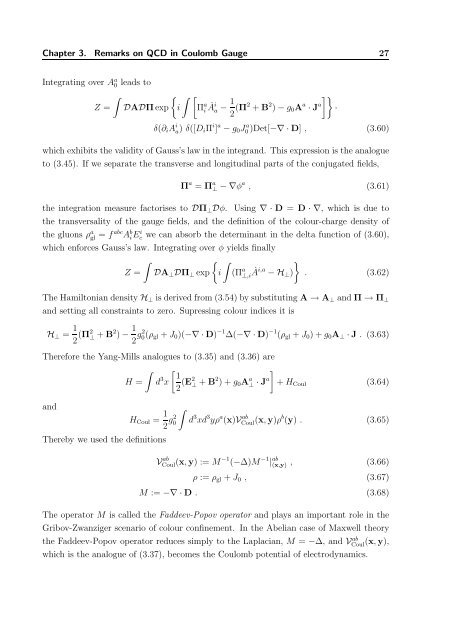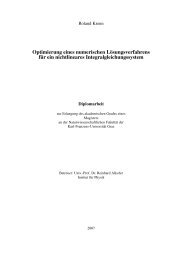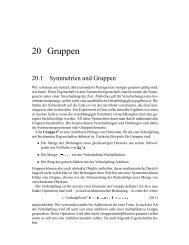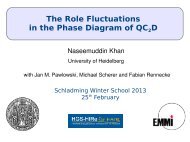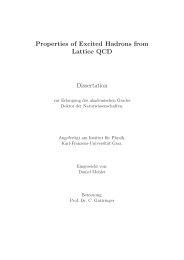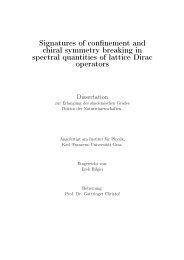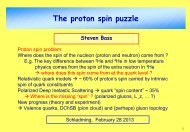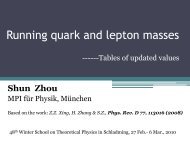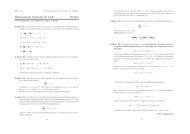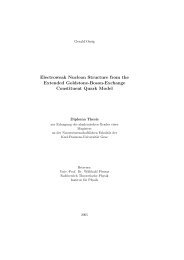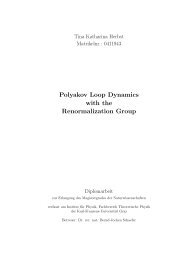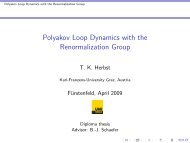The QCD Quark Propagator in Coulomb Gauge and - Institut für Physik
The QCD Quark Propagator in Coulomb Gauge and - Institut für Physik
The QCD Quark Propagator in Coulomb Gauge and - Institut für Physik
Create successful ePaper yourself
Turn your PDF publications into a flip-book with our unique Google optimized e-Paper software.
Chapter 3. Remarks on <strong>QCD</strong> <strong>in</strong> <strong>Coulomb</strong> <strong>Gauge</strong> 27<br />
Integrat<strong>in</strong>g over A a 0 leads to<br />
∫<br />
Z = DADΠexp<br />
{ ∫ [<br />
i Π a i Ȧi a − 1 ]}<br />
2 (Π2 + B 2 ) − g 0 A a · J a ·<br />
δ(∂ i A i a ) δ([D iΠ i ] a − g 0 J0 a )Det[−∇ · D] , (3.60)<br />
which exhibits the validity of Gauss’s law <strong>in</strong> the <strong>in</strong>tegr<strong>and</strong>. This expression is the analogue<br />
to (3.45). If we separate the transverse <strong>and</strong> longitud<strong>in</strong>al parts of the conjugated fields,<br />
Π a = Π a ⊥ − ∇φ a , (3.61)<br />
the <strong>in</strong>tegration measure factorises to DΠ ⊥ Dφ. Us<strong>in</strong>g ∇ · D = D · ∇, which is due to<br />
the transversality of the gauge fields, <strong>and</strong> the def<strong>in</strong>ition of the colour-charge density of<br />
the gluons ρ a gl = fabc A b i Ei c we can absorb the determ<strong>in</strong>ant <strong>in</strong> the delta function of (3.60),<br />
which enforces Gauss’s law. Integrat<strong>in</strong>g over φ yields f<strong>in</strong>ally<br />
∫<br />
{ ∫<br />
}<br />
Z = DA ⊥ DΠ ⊥ exp i (Π a ⊥,iȦi,a − H ⊥ ) . (3.62)<br />
<strong>The</strong> Hamiltonian density H ⊥ is derived from (3.54) by substitut<strong>in</strong>g A → A ⊥ <strong>and</strong> Π → Π ⊥<br />
<strong>and</strong> sett<strong>in</strong>g all constra<strong>in</strong>ts to zero. Supress<strong>in</strong>g colour <strong>in</strong>dices it is<br />
H ⊥ = 1 2 (Π2 ⊥ + B2 ) − 1 2 g2 0 (ρ gl + J 0 )(−∇ · D) −1 ∆(−∇ · D) −1 (ρ gl + J 0 ) + g 0 A ⊥ · J . (3.63)<br />
<strong>The</strong>refore the Yang-Mills analogues to (3.35) <strong>and</strong> (3.36) are<br />
∫ [ ]<br />
1<br />
H = d 3 x<br />
2 (E2 ⊥ + B2 ) + g 0 A a ⊥ · Ja + H Coul (3.64)<br />
<strong>and</strong><br />
H Coul = 1 2 g2 0<br />
∫<br />
d 3 xd 3 yρ a (x)V ab<br />
Coul (x,y)ρb (y) . (3.65)<br />
<strong>The</strong>reby we used the def<strong>in</strong>itions<br />
V ab<br />
Coul(x,y) := M −1 (−∆)M −1 | ab<br />
(x,y) , (3.66)<br />
ρ := ρ gl + J 0 , (3.67)<br />
M := −∇ · D . (3.68)<br />
<strong>The</strong> operator M is called the Faddeev-Popov operator <strong>and</strong> plays an important role <strong>in</strong> the<br />
Gribov-Zwanziger scenario of colour conf<strong>in</strong>ement. In the Abelian case of Maxwell theory<br />
the Faddeev-Popov operator reduces simply to the Laplacian, M = −∆, <strong>and</strong> V ab<br />
Coul (x,y),<br />
which is the analogue of (3.37), becomes the <strong>Coulomb</strong> potential of electrodynamics.


